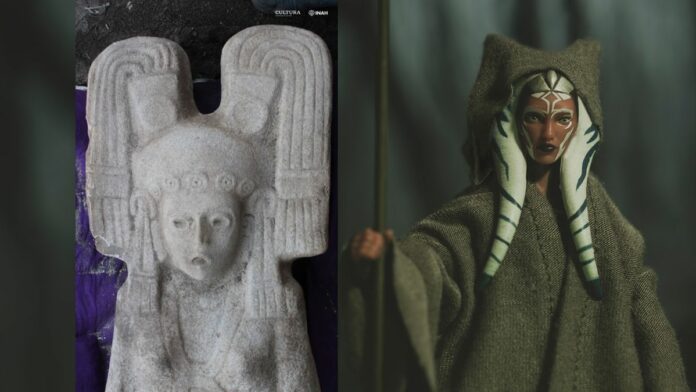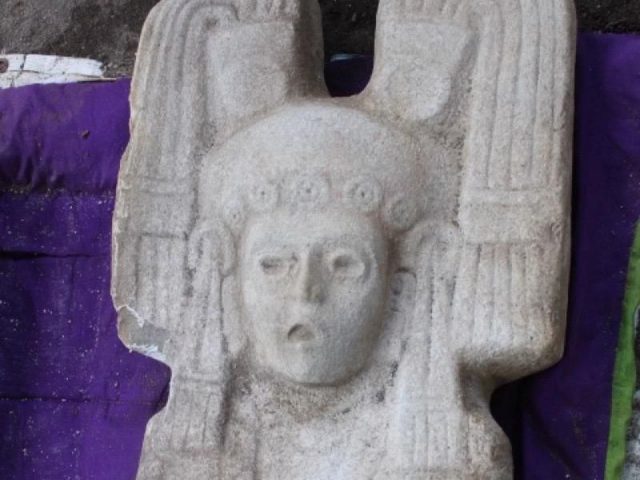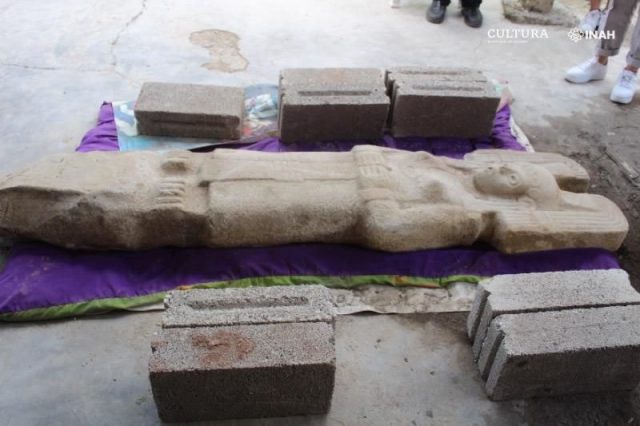The ‘Star Wars’ Statue: How an Ancient Mexican Find Captivates History and Sci-Fi Fans

On New Year’s Day, a surprising discovery was made in Central Mexico—a statue that bears a striking resemblance to a character from the iconic “Star Wars” franchise. The discovery was not made by professional archaeologists, but rather by citrus farmers ploughing a field in Hidalgo Amajac, Veracruz. This unexpected find has captured the imagination of both history enthusiasts and “Star Wars” fans alike.
A Galactic Resemblance: The Star Wars Connection

The 6.5-foot limestone statue has intrigued fans due to its resemblance to Ahsoka Tano, a character from the “Star Wars” animated series who later appeared in the live-action series “The Mandalorian” on Disney+. The statue’s head-dress, in particular, has been compared to Ahsoka’s distinctive appearance, adding a cosmic twist to the discovery.
Unveiling the Real History Behind the Statue
Despite the “Star Wars” comparison, the statue is rooted in a rich historical context. According to Live Science, the figure represents a young woman adorned with significant attire and ornaments, including a circular pendant known as an ‘oyohualli’ on a thick necklace. This portrayal reflects the status and influence of the individual depicted.
INAH (National Institute of Anthropology and History) later examined the statue and revealed it as the first of its kind discovered in the region. They describe the site as “a hitherto unknown but extensive archaeological site,” suggesting the presence of a previously undiscovered historical area.
Cultural and Historical Significance

The statue was found between the pre-Columbian archaeological site of El Tajín and the Aztec city of Tuxan. It shares characteristics with statues created by the Huastec people, who lived in the northeast Gulf Coast region from around 1500 BC until their displacement by the Aztecs. The statue dates to the Postclassic Period, approximately 1450–1521 AD.
The Huastec people, descendants of the Maya, were known for their powerful feminine statues emphasizing power and fertility. The aesthetics of the statue may also reflect influences from Tlazoltéotl, the Aztec goddess of impurity.
Unique Features and Theories

The statue’s eyes, now devoid of their original stone inlays, and its surprised expression suggest possible connections to the Nahua people, another ancient Native American group. The statue also features a spike at its base, which may have been used to secure it into the ground.
According to INAH’s statement, Mexico’s Secretary of Culture Alejandra Frausto Guerrero noted that the statue underscores “the active participation of ruling women in the Huasteca social and political structure.” This finding highlights a society that once celebrated female leadership, a stark contrast to the diminished status of women post-European conquest.
Current Exploration and Community Impact
Ongoing explorations by INAH are investigating whether the statue was transported from a different location. The mystery surrounding its presence in the grove and its singular placement continues to intrigue researchers.
Leading archaeologist María Eugenia Maldonado Vite suggests that the statue may represent a powerful mortal woman or a figure of divine significance, blending human and deity attributes.
The discovery has brought a sense of pride and renewed identity to the local community. Jorge Vera Hernández, Mayor of Álamo Temapache, expressed that the statue symbolizes local resilience and serves as a testament to the region’s enduring history.
Conclusion
While the ancient statue may not wield a lightsaber, its connection to “Star Wars” has undoubtedly amplified its allure. The statue’s real story reveals a fascinating blend of historical significance and cultural depth. As research continues, the figure’s role in ancient society and its journey to its current resting place will further enrich our understanding of Mexico’s ancient civilizations.
Video
News
The Hanging Temple: China’s 1,500-Year-Old Cliffside Marvel of Faith and Engineering
The Hanging Temple: China’s 1,500-Year-Old Cliffside Marvel of Faith and Engineering Perched precariously on the cliffs of Mount Heng in Shanxi Province, China, the Hanging Temple, also known as Xuankong Temple, Hengshan Hanging Temple, or Hanging Monastery, is an architectural…
The Willendorf Venus: A 30,000-Year-Old Masterpiece Reveals Astonishing Secrets
The Willendorf Venus: A 30,000-Year-Old Masterpiece Reveals Astonishing Secrets The “Willendorf Venus” stands as one of the most revered archaeological treasures from the Upper Paleolithic era. Discovered in 1908 by scientist Johann Veran near Willendorf, Austria, this small yet profound…
Unveiling the Maya: Hallucinogens and Rituals Beneath the Yucatán Ball Courts
Unveiling the Maya: Hallucinogens and Rituals Beneath the Yucatán Ball Courts New archaeological research has uncovered intriguing insights into the ritual practices of the ancient Maya civilization. The focus of this study is a ceremonial offering found beneath the sediment…
Uncovering the Oldest Agricultural Machine: The Threshing Sledge’s Neolithic Origins
Uncovering the Oldest Agricultural Machine: The Threshing Sledge’s Neolithic Origins The history of agricultural innovation is a fascinating journey that spans thousands of years, and one of the earliest known agricultural machines is the threshing sledge. Recently, a groundbreaking study…
Nara’s Ancient Sword: A 1,600-Year-Old Protector Against Evil Spirits
Nara’s Ancient Sword: A 1,600-Year-Old Protector Against Evil Spirits In a remarkable discovery that has captured the attention of archaeologists and historians alike, a 7.5-foot-long iron sword was unearthed from a 1,600-year-old burial mound in Nara, Japan. This oversized weapon,…
The Inflatable Plane, Dropped Behind the Lines for Downed Pilots
Experimental The Inflatable Plane, Dropped Behind the Lines for Downed Pilots The Inflatoplane from Goodyear was an unconventional aircraft developed by the Goodyear Aircraft Company, a branch of the renowned Goodyear Tire and Rubber Company, also famed for the Goodyear…
End of content
No more pages to load











